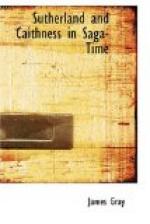If one may venture to hazard a conjecture as to their date, they probably came into general use in these parts of Caledonia as nearly as possible contemporaneously with the date of the Roman occupation of South Britain, which they outlasted for many centuries. But their erection was not due to the fear of attack by the armies of Rome. For their remains are found where the Romans never came, and where the Romans came almost none are found. Their construction is more probably to be ascribed to very early unrecorded maritime raids of pirates of unknown race both on regions far north of the eastern coast protected later by the Count of the Saxon shore, and on the northern and western islands and coasts, where also many ruins of them survive.
In Cat dwelt the Pecht or Pict, the Brugaidh or farmer in his dun or broch, erected always on or near well selected fertile land on the seaboard, on the sides of straths, or on the shores of lochs, or less frequently on islands near their shores and then approached by causeways;[6] and the rest of the people lived in huts whose circular foundations still remain, and are found in large numbers at much higher elevations than the sites of any brochs. The brochs near the sea-coast were often so placed as to communicate with each other for long distances up the valleys, by signal by day, and beacon fire at night, and so far as they are traceable, the positions of most of them in Sutherland and Caithness are indicated on the map by circles.
Built invariably solely of stone and without mortar, in form the brochs were circular, and have been described as truncated cones with the apex cut off,[7] and their general plan and elevation were everywhere almost uniform. The ground floor was solid masonry, but contained small chambers in its thickness of about 15 feet. Above the ground floor the broch consisted of two concentric walls about three feet apart, the whole rising to a height in the larger towers of 45 feet or more, with slabs of stone laid horizontally across the gap between and within the two walls, at intervals of, say, five or six feet up to the top, and thus forming a series of galleries inside the concentric walls, in which large numbers of human beings could be temporarily sheltered and supplies in great quantities could be stored for a siege. These galleries were approached from within the broch by a staircase which rose from the court and passed round between the two concentric walls above the ground floor, till it reached their highest point, and probably ended immediately above the only entrance, the outside of which was thus peculiarly exposed to missiles from the end of the staircase at the top of the broch. The only aperture in the outer wall was the entrance from the outside, about 5 feet high by 3 feet wide, fitted with a stone door, and protected by guard-chambers immediately within it, and it afforded the sole means of ingress to and egress from the interior court,




